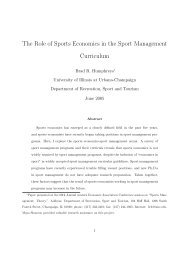You also want an ePaper? Increase the reach of your titles
YUMPU automatically turns print PDFs into web optimized ePapers that Google loves.
Two In<br />
One Shot<br />
by Nick Nikolaidis<br />
Want to see how Nick makes this shot? Log on<br />
to: poolmag.com/Cool_Pool_Videos.cfm, OR<br />
watch it RIGHT HERE in your Ezine!<br />
If you have a shot you’d like me to try or have<br />
a cool idea, send it to Nick’s attention at:<br />
Poolmag@poolmag.com<br />
Watch &<br />
Learn!<br />
by Shari J. Stauch<br />
Shari Stauch is the Executive Editor of Pool &<br />
Billiard Magazine, co-author of Precision Pool and<br />
The Pool Player’s Edge, and a 20 year veteran of the<br />
Women’s Pro Billiard Tour. She was inducted into the<br />
WPBA Hall of Fame in 2007.<br />
26<br />
P&BÊA ugustÊ2009<br />
It’s always<br />
exciting to<br />
watch a lot<br />
of balls drop with<br />
a single strike of<br />
the cue. How many<br />
balls have you<br />
made on one strike?<br />
Try your luck with<br />
this shot and inspire<br />
your imagination<br />
to shoot for more!<br />
THE SET UP<br />
Place the cue ball<br />
on the center-line of the table and on the<br />
3rd diamond from the short rail.<br />
Freeze 2 balls to each side of the cue ball and<br />
have them lined-up towards the side pockets.<br />
Set 2 balls as indicated near each of the side<br />
pockets with the setup line aiming slightly off<br />
the point of the corner pocket. (This will allow<br />
for the throw of the 2nd ball into the corner).<br />
Ever stop to pay attention – real attention<br />
– to what your opponent is doing at<br />
the table? Or to what the pros are<br />
doing as they stride around the pool table on TV?<br />
If not, it’s time to start. Your knowledge will be<br />
enhanced by observing what ‘s happening on<br />
the playing surface of any competitive match.<br />
Think of your brain as a bank, and every<br />
shot, pattern, strategy you see as a deposit<br />
in your account. Applied watching and<br />
learning from others will step your game<br />
up faster than you can say, “Rack ‘em.”<br />
Here’s four quick “watch and learn” tips to get<br />
you making more frequent deposits in no time:<br />
1. What’s the best shot on the table? What<br />
would you do if it were your shot? After a quick<br />
survey of the table, determine the strategy you<br />
would take, then observe what the shooter does.<br />
Did the shooter’s plan match yours? Did the plan<br />
conclude satisfactorily or did it go awry? Could<br />
anything have been done to change the outcome?<br />
By remembering the concept of the shot, you’ll be<br />
able to recognize a similar situation in the future.<br />
2. Why did he/she do that? Sometimes the<br />
player you’re watching (yes, even your opponent)<br />
Nick’s Quick Tricks<br />
Finally, the famous 2 ball split up table on<br />
the rack spot. (Minor adjustments may be<br />
required for precision)<br />
THE EXECUTION:<br />
The execution of this shot is much simpler<br />
than it looks. Once the setup is complete, simply<br />
use a center strike on the cue ball and aim for<br />
dead center hit on the split shot up table.<br />
Try various speeds to help you refine the shot.<br />
Head Games<br />
will do something that you don’t understand.<br />
Sometimes he/she has a plan in mind that<br />
hasn’t occurred to you. There is an advantage<br />
and a disadvantage to every shot. By observing,<br />
for example, a situation where your opponent<br />
played a good safe when you would have<br />
opted for a bank, you can learn more about the<br />
risk and reward factors in your own game.<br />
3. Observe everyone. It’s just as important to<br />
witness unsuccessful strategies as it is to witness<br />
brilliant execution. What works – or doesn’t – can<br />
be learned from any player. And, while you may<br />
assume that you learn the most from seasoned<br />
players, the fact is that many beginners have<br />
a unique approach they’ve invented without<br />
the encumbrance of traditional teaching,<br />
and that approach may just work for you!<br />
4. What are your opponent’s strengths and<br />
weaknesses? The best strategists know the<br />
strengths and weaknesses of their opponent, so<br />
keep an eye on things in your own match. Bonus:<br />
When you observe an opponent objectively,<br />
you achieve a level of detachment that keeps<br />
the game analytical, rather than succumbing<br />
to emotional and psychological responses.<br />
ÊÊÊÊwww .poolmag.comÊ

















